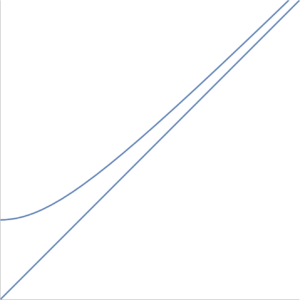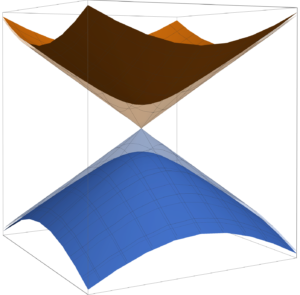[Click here for a PDF of this post with nicer formatting]
In the borrowed notes I have for last Monday’s lecture (which I missed) I see the momentum operator defined by
\begin{equation}\label{eqn:momentumDirac:20}
\BP = \sum_{s = 1}^2
\int \frac{d^3 q}{(2\pi)^3} \Bp \lr{
a_\Bp^{s\dagger}
a_\Bp^{s}
+
b_\Bp^{s\dagger}
b_\Bp^{s}
}.
\end{equation}
There’s a “use Noether’s theorem” comment associated with this. For the scalar field, using Noether’s theorem, we identified the conserved charge of a spacetime translation as the momentum operator
\begin{equation}\label{eqn:momentumDirac:40}
P^i = \int d^3 x T^{0i} = – \int d^3 x \pi(x) \spacegrad \phi(x),
\end{equation}
and if we plugged in the creation and anhillation operator representation of \( \pi, \phi \), out comes
\begin{equation}\label{eqn:momentumDirac:60}
\BP =
\inv{2} \int \frac{d^3 q}{(2\pi)^3} \Bp \lr{ a_\Bp^\dagger a_\Bp + a_\Bp a_\Bp^\dagger},
\end{equation}
(plus \( e^{\pm 2 i \omega_\Bp t} \) terms that we can argue away.)
It wasn’t clear to me how this worked with the Dirac field, but it turns out that this does follow systematically as expected. For a spacetime translation
\begin{equation}\label{eqn:momentumDirac:80}
x^\mu \rightarrow x^\mu + a^\mu,
\end{equation}
we find
\begin{equation}\label{eqn:momentumDirac:100}
\delta \Psi = -a^\mu \partial_\mu \Psi,
\end{equation}
so for the Dirac Lagrangian, we have
\begin{equation}\label{eqn:momentumDirac:120}
\begin{aligned}
\delta \LL
&= \delta \lr{ \overline{\Psi} \lr{ i \gamma^\mu \partial_\mu – m } \Psi } \\
&=
(\delta \overline{\Psi}) \lr{ i \gamma^\mu \partial_\mu – m } \Psi
+
\overline{\Psi} \lr{ i \gamma^\mu \partial_\mu – m } \delta \Psi \\
&=
(-a^\sigma \partial_\sigma \overline{\Psi}) \lr{ i \gamma^\mu \partial_\mu – m } \Psi
+
\overline{\Psi} \lr{ i \gamma^\mu \partial_\mu – m } (-a^\sigma \partial_\sigma \Psi ) \\
&=
-a^\sigma \partial_\sigma \LL \\
&=
\partial_\sigma (-a^\sigma \LL),
\end{aligned}
\end{equation}
i.e. \( J^\mu = -a^\mu \LL \).
To plugging this into the Noether current calculating machine, we have
\begin{equation}\label{eqn:momentumDirac:160}
\begin{aligned}
\PD{(\partial_\mu \Psi)}{\LL}
&=
\PD{(\partial_\mu \Psi)}{} \lr{ \overline{\Psi} i \gamma^\sigma \partial_\sigma \Psi – m \overline{\Psi} \Psi } \\
&=
\overline{\Psi} i \gamma^\mu,
\end{aligned}
\end{equation}
and
\begin{equation}\label{eqn:momentumDirac:180}
\PD{(\partial_\mu \overline{\Psi})}{\LL} = 0,
\end{equation}
so
\begin{equation}\label{eqn:momentumDirac:140}
\begin{aligned}
j^\mu
&=
(\delta \overline{\Psi}) \PD{(\partial_\mu \overline{\Psi})}{\LL}
+
\PD{(\partial_\mu \Psi)}{\LL} (\delta \Psi)
– a^\mu \LL \\
&=
\overline{\Psi} i \gamma^\mu (-a^\sigma \partial_\sigma \Psi)
– a^\sigma {\delta^{\mu}}_{\sigma} \LL \\
&=
– a^\sigma
\lr{
\overline{\Psi} i \gamma^\mu \partial_\sigma \Psi
+ {\delta^{\mu}}_{\sigma} \LL
} \\
&=
-a_\nu
\lr{
\overline{\Psi} i \gamma^\mu \partial^\nu \Psi
+ g^{\mu\nu} \LL
}.
\end{aligned}
\end{equation}
We can now define an energy-momentum tensor
\begin{equation}\label{eqn:momentumDirac:200}
T^{\mu\nu}
=
\overline{\Psi} i \gamma^\mu \partial^\nu \Psi
+ g^{\mu\nu} \LL.
\end{equation}
A couple things are of notable in this tensor. One is that it is not symmetric, and there’s doesn’t appear to be any hope
of making it so. For example, the space+time components are way different
\begin{equation}\label{eqn:momentumDirac:220}
\begin{aligned}
T^{0k} &= \overline{\Psi} i \gamma^0 \partial^k \Psi \\
T^{k0} &= \overline{\Psi} i \gamma^k \partial^0 \Psi,
\end{aligned}
\end{equation}
so if we want a momentum like creature, we have to use \( T^{0k} \), not \( T^{k0} \). The charge associated with that current is
\begin{equation}\label{eqn:momentumDirac:240}
\begin{aligned}
Q^k
&=
\int d^3 x
\overline{\Psi} i \gamma^0 \partial^k \Psi \\
&=
\int d^3 x
\Psi^\dagger (-i \partial_k) \Psi,
\end{aligned}
\end{equation}
or translating from component to vector form
\begin{equation}\label{eqn:momentumDirac:260}
\BP =
\int d^3 x
\Psi^\dagger (-i \spacegrad) \Psi,
\end{equation}
which is the how the momentum operator is first stated in [2]. Here the vector notation doesn’t have any specific representation, but it is interesting to observe how this is directly related to the massless Dirac Lagrangian
\begin{equation}\label{eqn:momentumDirac:280}
\begin{aligned}
\LL(m = 0)
&=
\overline{\Psi} i \gamma^\mu \partial_\mu \Psi \\
&=
\Psi^\dagger i \gamma^\mu \partial_\mu \Psi \\
&=
\Psi^\dagger i (\partial_0 + \gamma_0 \gamma^k \partial_k) \Psi \\
&=
\Psi^\dagger i (\partial_0 – \gamma_0 \gamma_k \partial_k ) \Psi,
\end{aligned}
\end{equation}
but since \( \gamma_0 \gamma_k \) is a \( 4 \times 4 \) representation of the Pauli matrix \( \sigma_k \) Lagrangian itself breaks down into
\begin{equation}\label{eqn:momentumDirac:300}
\LL(m = 0)
=
\Psi^\dagger i \partial_0 \Psi
+
\Bsigma \cdot \lr{ \Psi^\dagger (-i\spacegrad) \Psi },
\end{equation}
components, and lo and behold, out pops the momentum operator density! There is ambiguity as to what order of products \( \gamma_0 \gamma_k \), or \( \gamma_k \gamma_0 \) to pick to represent the Pauli basis ([1] uses \( \gamma_k \gamma_0 \)), but we also have sign ambiguity in assembling a Noether charge from the conserved current, so I don’t think that matters. Some part of this should be expected this since the Dirac equation in momentum space is just \( \gamma \cdot p – m = 0 \), so there is an intimate connection with the operator portion and momentum.
The last detail to fill in is going from \ref{eqn:momentumDirac:260} to \ref{eqn:momentumDirac:20} using the \( a, b\) representation of the field. That’s an algebraically messy looking job that I don’t feel like trying at the moment.
References
[1] C. Doran and A.N. Lasenby. Geometric algebra for physicists. Cambridge University Press New York, Cambridge, UK, 1st edition, 2003.
[2] Michael E Peskin and Daniel V Schroeder. An introduction to Quantum Field Theory. Westview, 1995.

